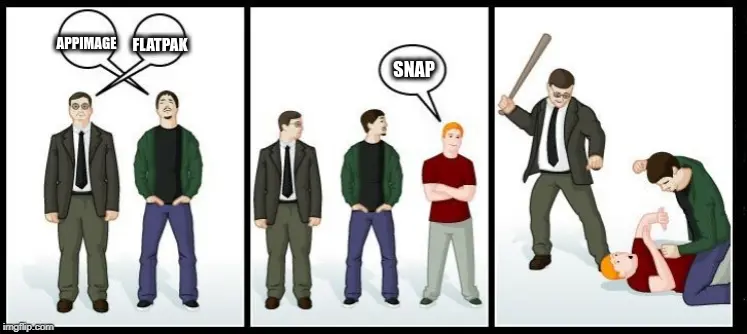this post was submitted on 16 Sep 2024
843 points (97.5% liked)
linuxmemes
21180 readers
1146 users here now
Hint: :q!
Sister communities:
- LemmyMemes: Memes
- LemmyShitpost: Anything and everything goes.
- RISA: Star Trek memes and shitposts
Community rules (click to expand)
1. Follow the site-wide rules
- Instance-wide TOS: https://legal.lemmy.world/tos/
- Lemmy code of conduct: https://join-lemmy.org/docs/code_of_conduct.html
2. Be civil
- Understand the difference between a joke and an insult.
- Do not harrass or attack members of the community for any reason.
- Leave remarks of "peasantry" to the PCMR community. If you dislike an OS/service/application, attack the thing you dislike, not the individuals who use it. Some people may not have a choice.
- Bigotry will not be tolerated.
- These rules are somewhat loosened when the subject is a public figure. Still, do not attack their person or incite harrassment.
3. Post Linux-related content
- Including Unix and BSD.
- Non-Linux content is acceptable as long as it makes a reference to Linux. For example, the poorly made mockery of
sudoin Windows. - No porn. Even if you watch it on a Linux machine.
4. No recent reposts
- Everybody uses Arch btw, can't quit Vim, and wants to interject for a moment. You can stop now.
Please report posts and comments that break these rules!
founded 1 year ago
MODERATORS
you are viewing a single comment's thread
view the rest of the comments
view the rest of the comments

I don't think snaps are bad (and when someone tries to explain why they are, about 85% of the time they say something wrong enough that I suspect they're probably just parroting someone else rather than actually knowing what's going on). It's sad, because if we could get rid of the bullshit we could actually have decent discussions about the benefits and shortcomings of snaps (and how to fix those shortcomings).
On the .deb front: it's a package format made by Debian. Each archive contains a data tarball, which has the files in the package in their full structure from
/, and a control tarball, which contains metadata such as name, version and dependencies as well as pre-install, pre-remove, post-install and post-remove scripts, which are used doing any setup or removal work that can't be done just by extracting or deleting the files.The upside of deb files is that they tend to be pretty small. The downside is that this typically comes from having a tight coupling to library versions on the system, which means upgrading a library can break seemingly unrelated things. (This is why you get warnings like this page: https://wiki.debian.org/DontBreakDebian) Many third party distributors (e.g. Google with Chrome) take care of this by packaging most dependencies inside the deb, inflating the size.
Another major difference between packages like debs and rpms and newer formats like snaps and flatpaks is that the latter have confinement systems to prevent apps from having full access to your system.
Worth noting that the confinement of Flatpaks and Snaps can have major drawbacks. It has been a major pain in the ass to get Flatpaks working nicely with fractional scaling (think tiny cursor, huge text, tiny text etc etc)
Nothing in theory makes that an issue of flatpaks and snap, just that both rely on different means to interact with the host system that have been woefully slow to implement. If enough protocols are developed a flatpak or snap should be as capable as a native app with the safety benefits for free.
While you're right in pointing out that in theory it's basically as capable as native, it's a royal pain in the ass as it is right now, which disqualifies it from a great deal of applications.